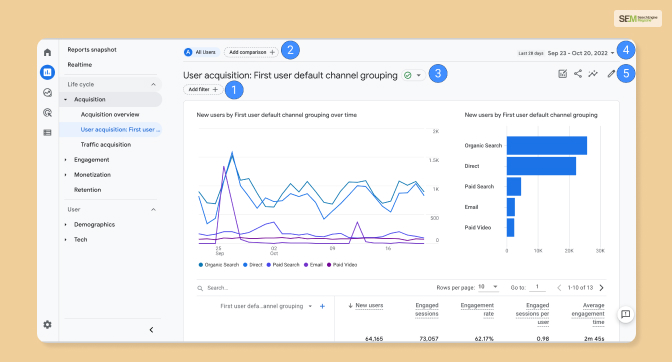How To Know If Someone Blocked You On iMessage? 5 Secret Hacks!
Apr 16, 2025

Apr 16, 2025

Apr 16, 2025

Apr 15, 2025

Apr 11, 2025

Apr 11, 2025

Apr 11, 2025

Apr 08, 2025

Mar 29, 2025
Sorry, but nothing matched your search "". Please try again with some different keywords.


One of the most common SEO questions that learners find in SEO tests is, “To recognize users across different devices, what is required for User ID?” In the options for the answers, generally, the following are provided: – Sign-in that generates and sets unique IDs, – Google Tag Manager, – A new Analytics account for reporting, – All of the above.
The answer to the question is “Sign-in that generates and sets unique IDs.” In this article, we will take a look at the question, as well as the explanation for the above answer. Furthermore, we will also look at the User ID feature that Google offers and the way in which the feature works in Google. If you want to know in detail about these aspects of SEO, read on through to the end of the article.
Read More: What Criteria Could Not Be Used To Create A Dynamic Remarketing Audience?

Many people use Google accounts for their daily purposes. A single user might use different devices to access the account. In such cases, it is important to recognize the user from the device and offer the user only the information that the user actually wants to see.
According to Google Analytics Help, you can “connect multiple devices, sessions, and engagement data to the same users. User-ID lets you associate a persistent ID for a single user with that user’s engagement data from one or more sessions initiated from one or more devices.”
Hence, you will see no matter which website you are opening from another device, and you will need to sign in to the account of the website. The same goes for Google accounts as well. On the other hand, you will need to ensure that you are providing the username and password, along with the security question, while you are signing in to the account.
The following subsection is a brief explanation of the importance of the sign-in procedure, which helps in generating and setting unique user IDs:

The job of a user ID is to enable one session or more sessions (as well as any activity/activities within these sessions) to be associated with each other. This user ID comes with a unique and persistent identity, which gets connected with the Analytics of the website.
If you want to implement the user ID in the sign-in process, you must be able to generate a unique Id of your own. Furthermore, you will need to assign user IDs to your website users consistently. Thereby, you will need to incorporate these unique IDs in all the places where you use the data in the Analytics platform.
According to Google Analytics Help, “Analytics interprets each unique user ID as a separate user, which provides a more accurate user count in your reports. When you send Analytics an ID and related data from multiple sessions, your reports tell a more unified, holistic story about a user’s relationship with your business.”
Suppose a situation occurs where you can tend to send Google Analytics the unique IDs of your users generated by the authentication system of your own website as values for the unique user ID of every user of your website. In such cases, there can be any form of engagement from the end of the user, including clicks on links, webpage history, screen navigation, or anything else that occurs after assigning a unique ID. You can send and connect these data in Google Analytics with the help of a User ID.
As per the definition of Google Analytics Help, “A User-ID view is a special reporting view that only displays data from sessions in which you send unique ID and related data to Analytics. To analyze all of your data, use a different view.”
Google claims that with the help of a User ID, you will be able to analyze a traffic segment that consists of a separately assigned ID from other traffic sources of your website. Apart from that, how you want to set up a user ID depends a lot on the environment in which you are operating your website. One of the common implementations of user IDs is when you assign user IDs during the sign-in procedure. Here, your users will need the user ID while signing in to your website.

According to Google Analytics, “In an Analytics implementation without the User-ID feature, a unique user is counted each time your content is accessed from a different device and each time there’s a new session… When you implement User-ID, you can identify related actions and devices and connect these seemingly independent data points.”
Once a user is signed in to the account and performs different searches at different times, you will be able to identify the actions of the combined number of users and will be able to connect “these seemingly independent data points.”
Google claims, “In this type of setup, you can analyze how signed-in users interact with your content, so you can find out more about how you acquired these users, what devices they use for different types of engagement, and how many sessions it takes to convert.”
The same search that the user did through different devices, and which previously looked like actions that were unrelated to each other, can now be considered as the action of a single user who is interacting with your business’ website.
Read More: What Data Table Display Compares Report Metrics To The Website Average?
Hope you have found this article helpful enough to answer your question, “To recognize users across different devices, what is required for User ID?” The sign-in that is required for the user ID is essential for gathering the data from the user so as to understand the buying behavior of every user. These factors make User IDs one of the most important factors in Analytics and improving the traffic of the website. What more usefulness of the User ID do you know of? Consider commenting below in the given section.
Read Also:
Inspired by The Social Network, Soumava loves to find ways to make small businesses successful – he spends most of his time analyzing case studies of successful small businesses. With 5+ years of experience in flourishing with a small MarTech company, he knows countless tricks that work in favor of small businesses. His keen interest in finance is what fuels his passion for giving the best advice for small business operations. He loves to invest his time familiarizing himself with the latest business trends and brainstorming ways to apply them. From handling customer feedback to making the right business decisions, you’ll find all the answers with him!
View all Posts
How To Know If Someone Blocked You On iMessag...
Apr 16, 2025
7 Website Design Mistakes That Are Hurting Yo...
Apr 16, 2025
Programmable Dynamic SEO for Location-Based P...
Apr 15, 2025
Google Boba Game: How To Play This Fun Game B...
Apr 11, 2025
Which Is The Best Video Search Engine Of 2025...
Apr 11, 2025

